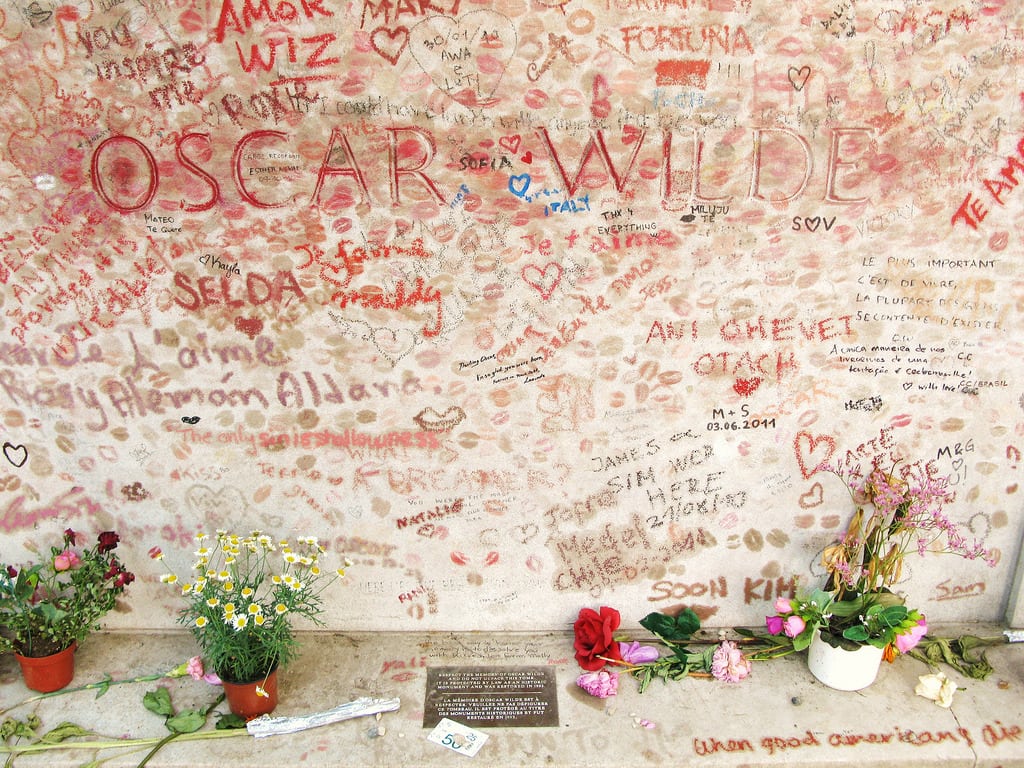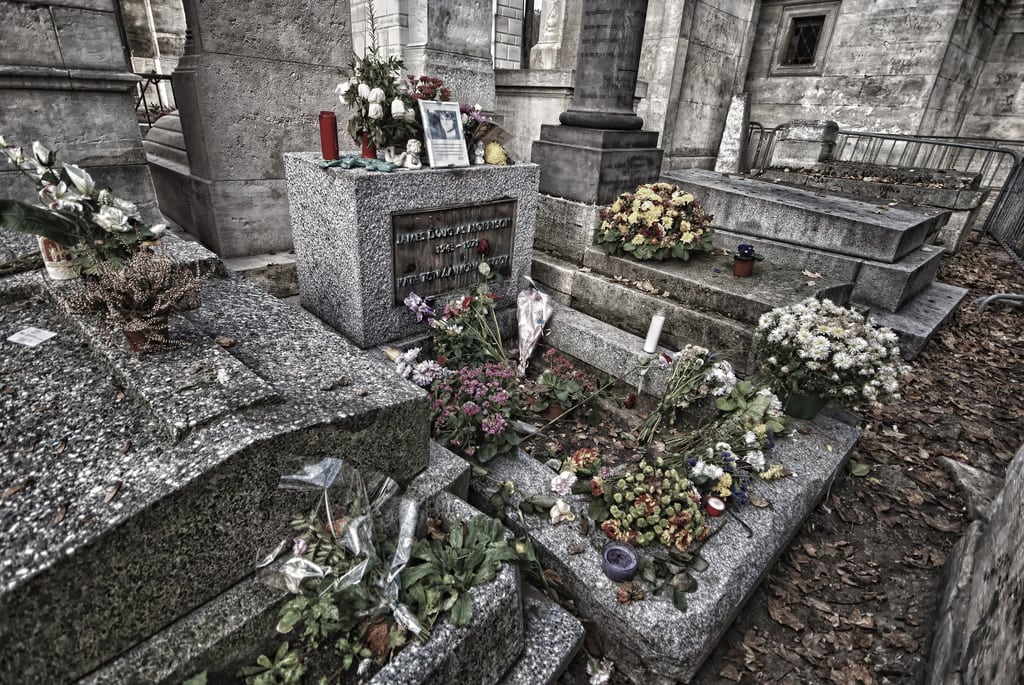Père-Lachaise, the most famous of Parisian cemeteries and the most visited in the world, the eternal home of some of the most brilliant and brilliant minds of all time such as Oscar Wilde, Jim Morrison and Frédéric Chopin. A must to discover the dark side of the Ville Lumière
Père-Lachaise: charming and romantic or gloomy and gloomy?

Over 800,000 souls rest in Paris’ most famous cemetery in the 20th arrondissement. The vastness of this place was one of the things that amazed me the most. And that continues to amaze me every time I come back here. The gravestones of the famous tombs follow one after the other. As if they were sea waves, they slide down the hill and almost seem to touch the city. With its 44 hectares, Père-Lachaise is the last resting place of some of the most illustrious minds, Chopin, Moliere, Edith Piaf, Rossini, Oscar Wilde, Jaques Luis David, just to name a few. The structure is so complicated that at the entrance they provide paper maps with the coordinates to trace the illustrious figures. A sort of treasure hunt for the dead.
The first time I walked through the gates of the cemetery was November 2008 and I was in Paris with friends to celebrate my eighteenth birthday. By mutual agreement, we decided to brave the autumn cold to pay homage to the greats of the past.
“Like a needle in a haystack” is the feeling that pervades those who, with their heads buried in the map, scrutinise the names among the tombstones in search of where Jim Morrison is buried or Oscar Wilde’s grave.
Dear adventurers of macabre and lugubrious adventures, do not despair!
Take your time, walk along the paths looking around, admire the sweetness from the hill and caress the trees with your eyes. And if you see a bunch of people crowding around a grave, hurry! Surely someone famous is buried there!
For this fascinating and funereal treasure hunt, I suggest you to stop for a moment at the entrance, locate on the map the graves you wish to visit and then venture into the anthill of lost lives in search of your favourite VIPs. We went a little bit randomly, but we had clear in mind who we wanted to give back to. Here is a list of our favourite dead people.
Oscar Wilde lies covered in lipstick kisses


More than a century after his death (1900), Wilde is remembered today as much for his literary prowess (e.g. The Picture of Dorian Gray) as for his exuberant personal life at the time. Imprisoned because he was accused of obscenity and sodomy, he was forced into forced labour where the only recommended readings were the Bible and The Pilgrim’s Progress, in prison his health began to deteriorate and once he was released, in almost complete poverty, he went to France where, reduced to no front teeth, he begged for coins. Various speculations hover around his death, some sources say that it was meningitis that took him away, others syphilis, others an otitis that degenerated with dramatic causes. Surely there was a prostitute, named Old Jess, but if she was the cause of his death we don’t know. Initially buried in the cemetery of Bagneux, outside Paris, in 1909 the remains of Wilde were then transferred to Père Lachaise. The imposing monument, erected by Jacob Epstein, which accompanies the tomb bears an epitaph taken from the Reading Prison Ballad:
“Unknown tears will fill the Urn of Mercy for him. He will have the moans of exiled men, for exiles there is only weeping.”
Fans have impressed pink and red kisses on the marble tomb, others have thought well to leave their signatures or small thoughts scratching the stone: often the line between vandalism and admiration is very thin.
Jim Morrison e il concetto di immortalità

Anyone who says that immortality does not exist is wrong. The physical one, of course. And it is in front of Jim Morrison’s tomb that one realises the vastness, the importance, that certain figures have had and will continue to have: some singers, musicians, artists have managed to touch strings so deep in the human soul that they become legendary, immortal, impermeable to the passing of time. Morrison is certainly one of these: so much so that everywhere in the world young girls steal his phrases to write them in school diaries, on desks, in bar toilets.
Each of us has a pair of wings, but only the dreamer learns to fly.
Jim Morrison is far from dead: he is alive and well and the tomb sprinkled with flowers and jewellery bears witness to this. Let’s turn up the volume and sing “come on baby, light my fire”.
Alas, some fans have tried to take a piece of tombstone away, others have clearly succeeded, the fact is that the tomb has suffered violent acts of vandalism and is now surrounded by a fence to discourage the more daring.
Be careful where you lean! In a very original way, some visitors have decorated a nearby tree with coloured (chewed) gum. Padlocks symbolising eternal love sprout like mushrooms around the grave. If you strain your ear you will hear lovers exchange promises “if I had to choose between your love and my life, I would choose your love, because it is my life” (J. Morrison).
Frédéric Chopin, the romantic pianist

Chopin, a Polish composer from the first half of the 19th century, died of tuberculosis at the young age of 39. Among my favourites, the composition Fantaisie Impromptu, Op 66. The sound of which rises, rises, rises in a tangle of notes until it stretches and relaxes in the central part, and then resumes the chase in an ascending climax of colours and vibrations.
“Every neglected difficulty will be a ghost which later disturbs your rest.”
While the heart rests in Warsaw, in the church of Santa Croce, the musician’s remains are in the Parisian cemetery, guarded by Euterpe, the muse of music who cries embracing a broken lyre.
Bizet and the beautiful gypsy
A contemporary of Chopin’s, Bizet gave music to Carmen, the story of a beautiful gypsy who doesn’t believe in the constancy of love, hers is a love as free as a rebel bird.
“Carmen will never give in! Free she was born and free she will die!”
Abelardo ed Eloisa

The oldest remains of the cemetery are undoubtedly those of Abelard and Eloise, a couple who secretly swore eternal love in 1100. After dedicating poems and poems, she got pregnant, he kidnapped her and married her, but being a cleric, they had to do everything in secret. When they were discovered, to avoid scandal, Abelard sent Eloisa to hide in a monastery, but her family, thinking that Abelard had forced her to become a nun, decided to attack him and castrate him.
The son was named Astrolabe. Eloisa, who became abbess, led an oratory and centre of culture. Abelard wore the habit of the monks of Cluny and became a monastery teacher. It seems that they died without ever seeing each other again, each wearing the clothes of the mission, in 1817 the remains of the two lovers were finally reunited and since then they have been resting together.
To tell the truth, three out of four, including myself, had art history as a curriculum subject, so one of the reasons we climbed up to Pére-Lachaise were the tombs of the artists Delacroix and Jaques Luis David.

Eugène Delacroix: the Prince of Romantics
An unstoppable traveller, Delacroix has travelled through Europe and Africa guided by the fascination that exotic countries emanate. From his travels he drew inspiration and dipped his brush into the palette of the world and woven on canvas some of the masterpieces of the Romantic era.
Jacques-Louis David: the Regicide
David opened the way to neoclassicism, thus closing the frivolous chapter of Rococo that had marked the Ancien Régime. Fervent and active supporter of the French Revolution, he was imprisoned with his friend Robespierre and after Napoleon’s fall he went first to Brussels and then to Holland, finally he was run over by a cart at the theatre exit and died. Accused of regicide (Louis XVI) he could not be buried in France, so he found rest in Brussels. In the tomb at Père-Lachaise, it is said that the heart of the painter was buried there, resting with his wife’s body.
Père-Lachaise: monumental and multi-religious cemetery
It was 1804 when a Napoleonic decree opened the doors of the Pere Lachaise cemetery to other religious denominations, in particular Judaism and Islam. Unfortunately, as often happens, one step forward is accompanied by ten steps backwards: in 1881 a law abrogated the decree and prohibited the burial of faiths other than Catholicism.

Walking around you cannot help but notice the less “sexy” but equally interesting and fascinating tombs of “normal” people. Although their names have not gone down in history, the marble structures that sing the praises of life certainly do not go unnoticed. In fact, the Père Lachaise cemetery is not just a tourist attraction, it is the place where family, friends, workers, bakers, lawyers or professors are still buried today. Have respect for the pain of others, although it is a tourist attraction, it is above all a sacred place of recollection and prayer.
Everywhere giant mausoleums, lavish chapels, statues and even a pagoda dot the last residences of famous people. Powerful monuments overlook tombs of every kind, material and size: some are crumbling and rotting, perhaps a sign that the dynasty has broken down, others perfectly polished, probably the living are keeping them clean by adding flowers from time to time. All around, gigantic, monstrous, chestnut and cypress trees stand guard over the hill and protect the souls of those who have been buried here, in silence, in a green space that admires and observes the lights of Paris. Here, where everything is silent, everything is silent, a respite from the mundane chaos of the French capital, here where everything is still, muffled by a silence that reminds us of the transience of life, and strikes us from within so that we can live fully.
Useful info The cemetery is divided into quadrants, as if it were a naval battle or a huge chessboard. Some of the graves we have seen in this article are in the following divisions: Oscar Wilde: 89 Jim Morrison: 6 Frederic Chopin: 11 Don’t worry, at the entrance you will find a handy paper map that will lead you along the route. The most touristy tombs, however, are clearly recognisable by the crowded crowd around them.
How to get there Metro: take line 2 or 3 and get off at the Père-Lachaise stop which corresponds to the East corner of the cemetery at Philippe Auguste station on line 2. Not everyone knows that… If you prefer to go downhill, you can get off at the next stop, Gambetta, which is the closest to Oscar Wilde’s tomb and will leave you at the top of the hill. The rest of the visit will then be downhill!
Map of Père-Lachaise Cemetery
To get the best orientation inside this famous cemetery there are fortunately several maps and maps available to visitors, both paper and mobile, but below you can find our map so you can help you plan your visit!





 by Roimax ltd
by Roimax ltd